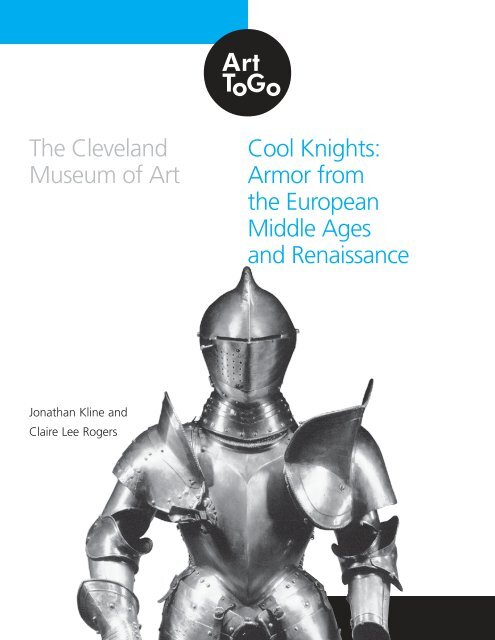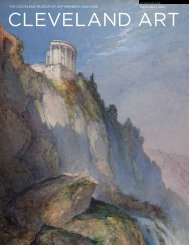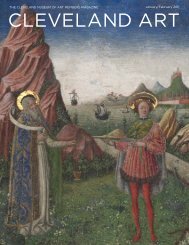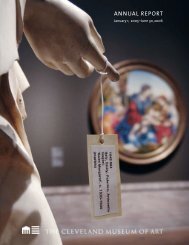Cool Knights: Armor from the European Middle Ages - Cleveland ...
Cool Knights: Armor from the European Middle Ages - Cleveland ...
Cool Knights: Armor from the European Middle Ages - Cleveland ...
You also want an ePaper? Increase the reach of your titles
YUMPU automatically turns print PDFs into web optimized ePapers that Google loves.
The <strong>Cleveland</strong><br />
Museum of Art<br />
Jonathan Kline and<br />
Claire Lee Rogers<br />
<strong>Cool</strong> <strong>Knights</strong>:<br />
<strong>Armor</strong> <strong>from</strong><br />
<strong>the</strong> <strong>European</strong><br />
<strong>Middle</strong> <strong>Ages</strong><br />
and Renaissance
Contents<br />
3 At a Glance<br />
A quick summary of <strong>the</strong><br />
presentation<br />
4 Why <strong>Armor</strong>? and Is It Art?<br />
An introduction in depth<br />
6 Questions and Answers<br />
Additional background and<br />
some useful definitions<br />
10 Things to Think About<br />
Questions to pique your<br />
students’ interest<br />
11 Talking Points and<br />
a List of Objects<br />
Basic concepts and a list of<br />
art works<br />
13 Lesson Plan<br />
Formatted especially for<br />
teachers<br />
14 Getting Ready for <strong>the</strong> Visit<br />
Some things you should know<br />
in advance, and some optional<br />
recommendations on how to<br />
configure a classroom<br />
14 “Webbing” <strong>Armor</strong><br />
How armor connects to o<strong>the</strong>r<br />
disciplines<br />
15 Suggestions for Fur<strong>the</strong>r<br />
Reading<br />
Books for students and teachers<br />
15 Website<br />
Information on how to reach<br />
<strong>the</strong> <strong>Cleveland</strong> Museum of Art<br />
over <strong>the</strong> internet and <strong>the</strong><br />
address for objects <strong>from</strong> our<br />
permanent collection of arms<br />
and armor<br />
2<br />
Also in your folder<br />
a. Presentation Evaluation<br />
After <strong>the</strong> presentation, please<br />
fill out <strong>the</strong> evaluation and<br />
return it to <strong>the</strong> museum.<br />
Thank you!<br />
b. Fax Sheet<br />
Already addressed to <strong>the</strong><br />
proper department of <strong>the</strong><br />
CMA, this form is for shorter<br />
questions or concerns relating<br />
to <strong>the</strong> Art To Go program.<br />
c. Art Project<br />
Make Your Own Helmet!<br />
Created by Bob Dewey<br />
A model for a class art project<br />
using simple materials
Introduction<br />
The purpose of this Teacher Preview packet is to<br />
prepare you for a visit <strong>from</strong> <strong>the</strong> Art To Go program<br />
of <strong>the</strong> <strong>Cleveland</strong> Museum of Art. The materials included<br />
inside should help you become familiar with<br />
<strong>the</strong> Art To Go program and with <strong>the</strong> topic of <strong>the</strong> presentation<br />
you have requested, arms and armor <strong>from</strong><br />
<strong>the</strong> <strong>European</strong> <strong>Middle</strong> <strong>Ages</strong> and Renaissance. Please<br />
use <strong>the</strong> materials, and feel free to share <strong>the</strong>m with<br />
your colleagues. You may freely reproduce <strong>the</strong> materials<br />
in <strong>the</strong> packet for educational purposes.<br />
At a Glance<br />
The <strong>Armor</strong> Suitcase contains seven pieces of armor<br />
and a single crossbow bolt, eight pieces in all. These<br />
objects come <strong>from</strong> <strong>the</strong> <strong>European</strong> <strong>Middle</strong> <strong>Ages</strong> and<br />
Renaissance—most are <strong>from</strong> <strong>the</strong> 16th century—and,<br />
for <strong>the</strong> most part, represent <strong>the</strong> kinds of armor worn<br />
by knights in those periods. The Art To Go presentation<br />
looks at <strong>the</strong>se objects in terms of <strong>the</strong> technological<br />
development and <strong>the</strong> artistry of armor. The Art<br />
To Go presentation also addresses some of <strong>the</strong> popular<br />
misconceptions of armor, for example, that a suit<br />
of armor was heavy or difficult to wear. The <strong>Armor</strong><br />
Suitcase includes an armored gauntlet that students<br />
can actually try on for first-hand experience of wearing<br />
armor.<br />
3
Why <strong>Armor</strong>?<br />
and Is It Art?<br />
At first <strong>the</strong> arms and armor of <strong>the</strong> <strong>European</strong> <strong>Middle</strong><br />
<strong>Ages</strong> and Renaissance may seem simply <strong>the</strong> remains<br />
of long-ago battles, wars fought in far-off lands, with<br />
little significance to modern viewers. But <strong>the</strong> arms<br />
and armors of old Europe are more than just curiosities.<br />
They are artifacts and works of art that, because<br />
of <strong>the</strong>ir durable nature and <strong>the</strong> care with which <strong>the</strong>y<br />
were kept, have survived <strong>the</strong> ravages of time. <strong>Armor</strong><br />
tells us about history. It makes history come alive.<br />
Most suits of armor were made for specific individuals<br />
– knights, kings, and emperors. Now, hundreds<br />
of years later, <strong>the</strong>se same suits help us reach back<br />
through <strong>the</strong> years, across oceans, and almost touch<br />
<strong>the</strong>se kings and princes <strong>from</strong> history.<br />
<strong>Armor</strong> also helps us to appreciate <strong>the</strong> ability of<br />
medieval and Renaissance artists and craftsmen.<br />
Each suit of armor is a technological marvel—made<br />
of perhaps hundreds of steel plates, joined toge<strong>the</strong>r<br />
with straps, buckles, hooks, and rivets, all constructed<br />
to fit perfectly on a single individual and<br />
offer both complete protection and complete freedom<br />
of movement. Just as modern technology develops,<br />
<strong>the</strong> technology of armor developed. Changes in<br />
<strong>the</strong> forms and capabilities of armor shaped <strong>European</strong><br />
history. Similarly, armor developed technologically<br />
in response to historical events. These masterpieces<br />
of craftsmanship and technology are, by <strong>the</strong>ir<br />
very nature, easily portable, so <strong>the</strong>y can be made<br />
4
available for first-hand viewing by scholars and students<br />
in American museums and schools.<br />
Surviving examples of early medieval arms and<br />
armor are essentially artifacts of war. They were first<br />
and foremost functional. With <strong>the</strong> passage of time,<br />
as armor developed in response to changes on <strong>the</strong><br />
battlefield and developments in weaponry, it also<br />
evolved into an artistic production. <strong>Armor</strong> always<br />
retained its functional aspect. It had to be well<br />
made, so that it moved fluidly with its wearer. At<br />
<strong>the</strong> same time, armor became increasingly a means<br />
of personal and artistic expression. The Renaissance<br />
prince in his etched and gilded parade armor was<br />
nobility personified. His armor held significance beyond<br />
its function and spoke not only of his military<br />
prowess, but also of his character and his own personal<br />
aes<strong>the</strong>tic in presenting himself.<br />
<strong>Armor</strong> also holds an interesting place in our own<br />
field of knowledge. Nearly everyone knows at least<br />
something about medieval and Renaissance armor,<br />
has some concept of how it looks and what it was<br />
for. Yet popular modern ideas of armor are often incorrect.<br />
The familiar concept of <strong>the</strong> medieval knight<br />
in shining armor is an anachronism. The knight in<br />
shining armor belongs to <strong>the</strong> Renaissance period,<br />
while <strong>the</strong> medieval knight was well equipped in a<br />
coat of mail. Popular belief holds that armor is, or<br />
should be, extremely heavy and difficult to wear<br />
and move, yet most armor is relatively light and extremely<br />
flexible. Ano<strong>the</strong>r widespread myth uses <strong>the</strong><br />
relatively small size of some suits of armor to sug-<br />
5
gest that people, in general, were shorter in those<br />
days. It may be <strong>the</strong> case, however, that <strong>the</strong> shorter<br />
suits were made to fit younger men and boys who<br />
had not grown to <strong>the</strong>ir full height. Indeed, many of<br />
our modern misconceptions derive <strong>from</strong> 18th- or<br />
19th-century romanticism, and have little to do with<br />
<strong>the</strong> reality of earlier periods. In going back to <strong>the</strong><br />
source, studying <strong>the</strong> actual plates of a Renaissance<br />
suit or witnessing <strong>the</strong> fluidity of movement within<br />
an armored gauntlet, we can begin to clear any false<br />
ideas handed down to us and better understand<br />
people and events <strong>from</strong> an important time in <strong>European</strong><br />
history.<br />
Questions<br />
and Answers<br />
What is armor?<br />
Broadly speaking, armor is any kind of equipment<br />
that is worn or carried for protection. Different<br />
kinds of armor were used by different cultures<br />
throughout history and over <strong>the</strong> entire world. This<br />
program focuses on armor worn in Europe in <strong>the</strong><br />
<strong>Middle</strong> <strong>Ages</strong> and Renaissance, <strong>from</strong> about 800 to<br />
around 1650. During this period, armor developed<br />
<strong>from</strong> mail, made of interlocking steel rings, to suits<br />
composed of overlapping steel plates. In <strong>the</strong> 17th<br />
century, as firearm technology advanced, armor became<br />
increasingly obsolete, and full suits of armor<br />
were generally not worn after about 1650.<br />
6
Who wore armor?<br />
Ordinary soldiers in <strong>the</strong> <strong>Middle</strong> <strong>Ages</strong> and Renaissance<br />
often worn some rudimentary armor. A wellmade<br />
coat of mail or, later, a fine suit of armor was<br />
<strong>the</strong> exclusive right of <strong>the</strong> nobility. <strong>Armor</strong> of high<br />
quality was extremely expensive, and none but <strong>the</strong><br />
very rich could afford it. What is more, many of<br />
<strong>the</strong> finest suits are covered in beautiful decoration<br />
that would have added considerably to <strong>the</strong> cost.<br />
These highly decorated suits of armor were owned<br />
by <strong>the</strong> highest in rank – <strong>the</strong> dukes, kings, or emperors<br />
of <strong>the</strong> later <strong>Middle</strong> <strong>Ages</strong> and Renaissance.<br />
What is a knight?<br />
A knight was a soldier, a well-trained warrior <strong>from</strong><br />
<strong>the</strong> nobility who fought for his religion, or for his<br />
king or country, or for himself. In <strong>the</strong>ory, a knight<br />
also lived by a strict code of behaviour. Under this<br />
code of chivalry, or knighthood, a knight was to<br />
honor his religion, his king, women, and those less<br />
fortunate than himself. The realities of life and war<br />
in Europe’s <strong>Middle</strong> <strong>Ages</strong> and Renaissance were certainly<br />
not as pure as <strong>the</strong>ir literature would suggest,<br />
and chivalry is, in large part, a literary construction.<br />
Yet it does seem that noble soldiers were expected to<br />
observe a code of honor on and off <strong>the</strong> battlefield,<br />
and certainly many of <strong>the</strong>m did try to distinguish<br />
<strong>the</strong>mselves as true knights by living a life of chivalry.<br />
7
Did <strong>the</strong>y really wear those fancy suits of armor<br />
into battles?<br />
Not every suit of armor was made for battle, though<br />
many have cuts and scratches to show that <strong>the</strong>y were<br />
actually worn in combat. O<strong>the</strong>r suits were made for<br />
tournament games that could be just as dangerous as<br />
real warfare. Some of <strong>the</strong> heaviest, most protective<br />
suits, in fact, are <strong>the</strong> jousting harnesses worn in<br />
equestrian tournaments. Tournament armor can be<br />
quite decorative, but is still very functional. A suit<br />
covered in fine etching and shining with gold is still<br />
steel underneath, and still designed to protect against<br />
swords and lances. There were, however, o<strong>the</strong>r suits<br />
of armor, called “parade armor,” which were even<br />
more decorative and designed simply for show. Parade<br />
armor would probably not have been worn in<br />
combat, ei<strong>the</strong>r in a real battle or in tournaments.<br />
How much does a suit of armor weigh?<br />
Most people tend to think of armor as heavy, bulky,<br />
and very difficult to move around in. In reality, armor<br />
had to be relatively light and extremely flexible.<br />
No one would have worn armor into battle unless it<br />
gave its wearer an advantage on <strong>the</strong> battlefield. Too<br />
much weight and immobility are not advantages. A<br />
well made suit of armor may weigh around 60<br />
pounds, distributed over <strong>the</strong> entire body. A knight in<br />
armor could move freely, run, get up after falling,<br />
mount and dismount his horse, all by himself. The<br />
plates in a suit of armor are actually ra<strong>the</strong>r thin and<br />
function not through mass or weight, but by deflecting<br />
a sword or arrow <strong>from</strong> angled surfaces.<br />
8
<strong>Armor</strong> always looks so small… were people<br />
shorter back <strong>the</strong>n?<br />
Some of <strong>the</strong> suits of armor that we see in museums<br />
look ra<strong>the</strong>r small. It only follows that <strong>the</strong> person<br />
who wore <strong>the</strong> suit was ra<strong>the</strong>r short. But this does<br />
not mean that every full grown male <strong>from</strong> 800 to<br />
1700 was stunted. We know, for example, that<br />
Charlemagne (742–814) and Henry VIII of England<br />
(1491–1547) were both over six feet tall. Then why<br />
are so many suits of armor so small? It may be <strong>the</strong><br />
case that <strong>the</strong> smaller suits of armor were made for<br />
younger men who had not yet grown to <strong>the</strong>ir full<br />
height. A future knight might have worn armor <strong>from</strong><br />
an early age, for practice and to present a correct appearance<br />
in dress parades. As he outgrew one suit,<br />
he would need ano<strong>the</strong>r, slightly larger. The smaller<br />
suits, made for boys as young as two years old, have<br />
child-like proportions and are easliy recognizable. A<br />
suit for a 16-year-old, however, may have <strong>the</strong> proportions<br />
of an adult, but be deceptively short.<br />
9
Things to Think About<br />
You may want to prepare your students with a<br />
few questions about armor. Here are a few sample<br />
questions that may pique <strong>the</strong>ir interest.<br />
If you were a king, or a duke, or maybe even an<br />
emperor, what kind of armor would you wear?<br />
What material would it be made of?<br />
What color would it be?<br />
How heavy is a suit of armor? Could you lift it over<br />
your head? Could you run in a suit of armor?<br />
Could you do a cartwheel in a suit of armor?<br />
How is a gauntlet like a lobster shell?<br />
Is a bolt of lightning anything like a crossbow bolt?<br />
Did women wear armor? Can you think of any<br />
women in history who did?<br />
Does anyone still use armor today?<br />
What kind of armor would you use to protect yourself<br />
against a shark’s bite? Against a hockey puck?<br />
Against radioactive contamination?<br />
10
Talking Points*<br />
Early in <strong>the</strong> <strong>Middle</strong> <strong>Ages</strong> (c. 800–c. 1500) soldiers<br />
wore mail armor into battle. Mail, composed of<br />
many thousands of linked steel rings, was flexible<br />
and relatively light and made very effective armor.<br />
In response to <strong>the</strong> development of mail-piercing<br />
weaponry, soldiers began to suppliment <strong>the</strong>ir mail<br />
with plates of steel formed to fit various parts of <strong>the</strong><br />
body. Eventually, plates were added to entirely cover<br />
<strong>the</strong> body. This new kind of armor, fully developed<br />
by <strong>the</strong> end of <strong>the</strong> 15th century, is what we usually<br />
think of as a suit of armor.<br />
A suit of armor is essentially clothing made of steel.<br />
As such, it must fit over <strong>the</strong> body and work with <strong>the</strong><br />
body, ra<strong>the</strong>r than against it. For a suit of armor to<br />
function properly, it had to be finely crafted. A well<br />
made suit of armor is a technological wonder.<br />
Only a member of <strong>the</strong> nobility had <strong>the</strong> right to wear<br />
a fine suit of armor, and only a member of <strong>the</strong> nobility<br />
could afford such an expensive suit. In <strong>the</strong> later<br />
history of armor, knights often had <strong>the</strong>ir suits elaborately<br />
decorated, to show <strong>the</strong>ir noble status and<br />
<strong>the</strong>ir refined artistic taste.<br />
11<br />
* An Art To Go presentation<br />
depends on<br />
personal interaction<br />
between a trained volunteer<br />
instructor and<br />
students in <strong>the</strong>ir own<br />
classroom. While <strong>the</strong><br />
objects stay <strong>the</strong> same,<br />
presentations may vary<br />
greatly, depending<br />
on <strong>the</strong> instructor and<br />
<strong>the</strong> involvement of <strong>the</strong><br />
students.
<strong>Armor</strong> was worn into battle, but also used in tournaments<br />
and worn in parades. Suits of armor for tournaments<br />
and parades were often made differently<br />
<strong>from</strong> each o<strong>the</strong>r and <strong>from</strong> field armor. A knowledgeable<br />
eye can usually figure out <strong>the</strong> function of any<br />
given suit of armor.<br />
Is armor still used today? Where? Is it similar or<br />
different <strong>from</strong> <strong>the</strong> kind of armor that was used in<br />
<strong>the</strong> <strong>European</strong> <strong>Middle</strong> <strong>Ages</strong> and Renaissance? Why?<br />
List of Objects*<br />
Fragment of mail. Date unknown.<br />
Quarrel (crossbow bolt). Germany or Austria,<br />
late 16th century.<br />
Breastplate. Germany or Austria, late 16th century.<br />
Vambrace. South Germany, 16th century with some<br />
19th-century restorations.<br />
Gauntlet for <strong>the</strong> right hand. Germany, late 16th<br />
century with some 19th-century restorations.<br />
Close helmet. South Germany, about 1590, possibly<br />
with some 19th-century restorations.<br />
At <strong>the</strong> discretion of <strong>the</strong> volunteer teacher and<br />
under <strong>the</strong> teacher’s close supervision, all objects<br />
except <strong>the</strong> close helmet may be handled by students.<br />
12<br />
* The Suitcase contents<br />
may vary, depending<br />
on <strong>the</strong> condition of <strong>the</strong><br />
objects.
Lesson Plan<br />
Resources<br />
The Focus<br />
Students will explore <strong>the</strong> <strong>Middle</strong><br />
<strong>Ages</strong> and Renaissance through<br />
actual museum artifacts—<strong>the</strong><br />
armor and weaponry of <strong>the</strong><br />
medieval and Renaissance knight.<br />
The Purpose<br />
Studying technological and artistic<br />
developments in a specific<br />
historical period to help us better<br />
understand technology and art<br />
in a broad sense. Seeing and<br />
handling real artifacts <strong>from</strong> <strong>the</strong><br />
<strong>Middle</strong> <strong>Ages</strong> and Renaissance<br />
can help us better understand a<br />
period and a warrior class that<br />
spark <strong>the</strong> interest of grade-school<br />
children even to <strong>the</strong> present day.<br />
The Motivation<br />
Introduce students to <strong>the</strong> material<br />
through engaging questions<br />
and answers, close observation<br />
of historical artifacts, discussion<br />
of artistic qualities, and direct<br />
handling of simple mechanical<br />
objects <strong>from</strong> medieval and<br />
Renaissance Europe.<br />
The Objectives<br />
The students will learn about<br />
knights <strong>from</strong> direct interaction<br />
with objects that belonged to<br />
knights and represented <strong>the</strong>ir<br />
particular status and purpose in<br />
society.<br />
Through observation and<br />
handling of simple mechanical<br />
objects and discussion of <strong>the</strong>ir<br />
relative advantages and disadvantages,<br />
<strong>the</strong> students will gain a<br />
better understanding of basic<br />
technological needs and developments.<br />
13<br />
The students will learn to see<br />
artistic beauty and symbolism in<br />
objects that <strong>the</strong>y may not initially<br />
consider works of art.<br />
The Input<br />
Students will be asked to respond<br />
to questions as <strong>the</strong> lesson<br />
is taught.<br />
The Check for Understanding<br />
Students will be asked to apply<br />
knowledge gained <strong>from</strong> examining<br />
one object toward understanding<br />
<strong>the</strong> forms and purposes<br />
of o<strong>the</strong>r objects shown later in<br />
<strong>the</strong> presentation.<br />
The homeroom teacher may<br />
follow up <strong>the</strong> presentation with<br />
curriculum materials and ideas<br />
taken <strong>from</strong> this packet or <strong>from</strong><br />
sources listed in <strong>the</strong> bibliography.<br />
The Closure<br />
Students will visit <strong>the</strong> <strong>Armor</strong><br />
Court of <strong>the</strong> <strong>Cleveland</strong> Museum<br />
of Art, where <strong>the</strong>y will be able to<br />
apply <strong>the</strong> knowledge <strong>the</strong>y have<br />
gained in handling individual<br />
pieces in <strong>the</strong>ir classroom toward<br />
an understanding – historical,<br />
technological, and artistic – of<br />
<strong>the</strong> complete suits of armor in<br />
<strong>the</strong> museum gallery.
Getting Ready<br />
for <strong>the</strong> Visit<br />
“Webbing”*<br />
*Suggestions for<br />
making art <strong>the</strong> center<br />
of student learning.<br />
Art<br />
Observe <strong>the</strong> decoration<br />
on a piece of armor.<br />
Talk about what it represents.<br />
Make or draw<br />
your own suit of armor.<br />
General Information<br />
The Art To Go presentation<br />
takes approximately 40 minutes.<br />
Anyone who wishes to handle<br />
<strong>the</strong> objects must wear gloves,<br />
which will be provided by <strong>the</strong> Art<br />
To Go staff.<br />
We respectfully request that a<br />
homeroom teacher or events coordinator<br />
be present and attentive<br />
during <strong>the</strong> presentation.<br />
Classroom Configuration<br />
Experience has shown that certain<br />
classroom configurations are<br />
more suited for an Art To Go presentation<br />
than o<strong>the</strong>rs:<br />
Please have a small table or<br />
desk available at <strong>the</strong> front of <strong>the</strong><br />
room. Please have <strong>the</strong> it clear<br />
when <strong>the</strong> Art To Go Teacher arrives.<br />
Ma<strong>the</strong>matics<br />
Count <strong>the</strong> number of<br />
rings in one square inch<br />
of mail, <strong>the</strong>n multiply<br />
to figure out how many<br />
rings in a whole suit.<br />
Count <strong>the</strong> plates in a<br />
gauntlet.<br />
Science<br />
Compare <strong>the</strong> physical<br />
properties of various<br />
metals used in making<br />
and decorating armor.<br />
Consider <strong>the</strong> technology<br />
used in making a<br />
flexible suit of steel.<br />
<strong>Armor</strong><br />
Writing/<br />
Language Arts<br />
Write a story about<br />
knights in armor. Write<br />
a short description of a<br />
piece of armor based<br />
on direct observation.<br />
Describe <strong>the</strong> experience<br />
of wearing armor.<br />
14<br />
If possible, arrange <strong>the</strong> students<br />
in a semicircle facing <strong>the</strong><br />
table or desk at <strong>the</strong> front of <strong>the</strong><br />
room. The Art To Go Teacher will<br />
pass objects <strong>from</strong> student to student.<br />
This is more easily done if<br />
<strong>the</strong> students are seated in a line<br />
than in clusters of desks.<br />
Please display <strong>the</strong> students’<br />
names clearly ei<strong>the</strong>r on <strong>the</strong>ir<br />
desks or on <strong>the</strong>mselves.<br />
We realize that it may not be<br />
possible for all teachers to rearrange<br />
<strong>the</strong>ir classrooms for an<br />
Art To Go presentation. It should<br />
be noted, however, that <strong>the</strong><br />
quality of <strong>the</strong> experience may be<br />
greatly improved by following<br />
<strong>the</strong>se recommendations and<br />
providing a suitable environment<br />
for <strong>the</strong> presentation.<br />
Social Studies<br />
Study <strong>the</strong> medieval and<br />
Renaissance periods.<br />
Consider <strong>the</strong> social<br />
status and duties of a<br />
knight. Research and<br />
compare armor <strong>from</strong><br />
different cultures.<br />
Biology<br />
Which animals wear<br />
armor? Compare <strong>the</strong><br />
tail of a lobster to <strong>the</strong><br />
overlapping plates in an<br />
armored gauntlet.<br />
Reading<br />
Read a story about<br />
knights in armor—try<br />
one of <strong>the</strong> many treatments<br />
of <strong>the</strong> legend of<br />
Arthur and <strong>the</strong> <strong>Knights</strong><br />
of <strong>the</strong> Round Table,<br />
Ivanhoe, by Walter<br />
Scott, or Don Quixote,<br />
by Cervantes.
Suggestions<br />
for Fur<strong>the</strong>r<br />
Reading<br />
Especially for Children<br />
We heartily recommend <strong>the</strong> Eyewitness<br />
Books series published by<br />
Alfred A. Knopf, New York. In<br />
relation to this particular Art To<br />
Go Suitcase, see Arms and <strong>Armor</strong><br />
by Michelle Byam and Dave King,<br />
and <strong>the</strong> o<strong>the</strong>r Eyewitness Books:<br />
Knight, Castle, Battle, and Medieval<br />
Life.<br />
Historical Background<br />
Arms & <strong>Armor</strong> by Stephen N.<br />
Fliegel (<strong>Cleveland</strong>: The <strong>Cleveland</strong><br />
Museum of Art, 1998)<br />
181 pages, with color illustrations,<br />
glossary, and checklist of<br />
objects. This easily read text<br />
considers <strong>the</strong> development of<br />
<strong>European</strong> arms and armor <strong>from</strong><br />
antiquity through <strong>the</strong> Renaissance,<br />
<strong>the</strong> decoration of arms<br />
and armor, and technical aspects.<br />
Based on <strong>the</strong> collections of <strong>the</strong><br />
<strong>Cleveland</strong> Museum of Art and<br />
published for <strong>the</strong> reinstallation of<br />
<strong>the</strong> <strong>Armor</strong> Court in 1998.<br />
Armourers by Matthias<br />
Pfaffenbichler (London: British<br />
Museum Press, 1992)<br />
72 pages, with color illustrations,<br />
glossary. Paperback only. Topquality<br />
publication on armor and<br />
<strong>the</strong> artists who made armor. Includes<br />
a wealth of information<br />
on how armor was made. May<br />
be difficult to find.<br />
An Historical Guide to Arms &<br />
<strong>Armor</strong> by Stephen Bull (New<br />
York: Facts on File, 1991)<br />
224 pages, with color illustrations.<br />
Good introduction and<br />
survey of arms and armor <strong>from</strong><br />
<strong>the</strong> Greeks to <strong>the</strong> modern era.<br />
Also includes chapters on firearms<br />
and arms and armor <strong>from</strong><br />
non-western cultures.<br />
15<br />
Arms and <strong>Armor</strong> in The Art Institute<br />
of Chicago by Walter J.<br />
Karcheski, Jr. (Chicago: The Art<br />
Institute of Chicago, 1995)<br />
128 pages, with color illustrations,<br />
glossary, and checklist of<br />
objects. Easy-to-read, this book<br />
presents numerous full color<br />
illustrations <strong>from</strong> <strong>the</strong> various collections<br />
of <strong>the</strong> Art Institute of<br />
Chicago. Includes basic history<br />
and discussion of armor, seen<br />
through this particular museum’s<br />
collection.<br />
<strong>Knights</strong> by Andrea Hopkins.<br />
(Shooting Star Press, Inc., 1990)<br />
191 pages, with color illustrations,<br />
maps, diagrams. Extensive<br />
discussion of knighthood—good<br />
introduction to <strong>the</strong> subject. Contains<br />
much information on arms<br />
and armor, including excellent<br />
illustrations of <strong>the</strong> development<br />
of armor (see pages 130–133).<br />
Additional sources, including articles<br />
and specialized studies, can<br />
be found through <strong>the</strong> bibliographies<br />
in <strong>the</strong> volumes listed above.<br />
Website<br />
www.clemusart.com<br />
We encourage teachers and students<br />
alike to visit <strong>the</strong> <strong>Cleveland</strong><br />
Museum of Art in person.<br />
We also encourage interested<br />
teachers and students to visit<br />
<strong>the</strong> museum’s website, where<br />
information about <strong>the</strong> museum’s<br />
collections and educational programs<br />
can be found.<br />
A ligh<strong>the</strong>arted approach to arms<br />
and armor in <strong>the</strong> <strong>Cleveland</strong><br />
Museum is presented at <strong>the</strong> same<br />
site through <strong>the</strong> education links.<br />
Click on “Defend Yourself,<br />
Good Knight” or go directly to<br />
http://www.clemusart.com/heal/<br />
armor
THE CLEVELAND<br />
MUSEUM OF ART<br />
Department of Education<br />
and Public Programs<br />
11150 East Boulevard<br />
<strong>Cleveland</strong>, Ohio<br />
44106–1797<br />
ART TO GO SERVICES<br />
216–421–7340 x 160<br />
TDD 216–421–0018<br />
FAX 216–421–9277<br />
info@cma-oh.org<br />
The Art To Go pilot program<br />
is sponsored by Eaton<br />
Corporation. Additional<br />
support is provided by <strong>the</strong><br />
National Endowment for<br />
<strong>the</strong> Arts, a federal agency,<br />
and Toshiba International<br />
Foundation.<br />
<strong>Cool</strong> <strong>Knights</strong>:<br />
<strong>Armor</strong> <strong>from</strong><br />
<strong>the</strong> <strong>European</strong><br />
<strong>Middle</strong> <strong>Ages</strong><br />
and Renaissance
Top<br />
Fold<br />
Cut out<br />
Punch hole<br />
This edge placed on fold of card stock<br />
Template for<br />
half of visor<br />
In <strong>the</strong> packet you<br />
will find patterns<br />
(templates) for a<br />
helmet and a visor.<br />
These were made on<br />
11” x 17” paper so<br />
that <strong>the</strong>y could be<br />
reproduced on a<br />
copy machine and<br />
used as patterns to<br />
be cut out and<br />
traced onto tougher<br />
material such as card<br />
stock or tag board.<br />
Construction paper<br />
is practical, but less<br />
desirable for<br />
strength.<br />
The helmet will require<br />
a 18” x 24”<br />
piece of stock. Fold<br />
it in half. It should<br />
now be 12" x 18".<br />
Place <strong>the</strong> inside edge<br />
of <strong>the</strong> helmet pat-<br />
Created by Bob Dewey<br />
tern on <strong>the</strong> folded<br />
edge of stock, trace<br />
it carefully, and cut it<br />
out.<br />
Cutting <strong>the</strong> material<br />
folded saves time<br />
and insures that <strong>the</strong><br />
final product will be<br />
more symmetrical.<br />
Folds add strength<br />
to <strong>the</strong> card stock just<br />
as <strong>the</strong>y do to <strong>the</strong><br />
steel of a real helmet.<br />
Now would be<br />
a good time to<br />
punch <strong>the</strong> holes<br />
needed for assembly.<br />
Cut on solid lines.<br />
Dotted lines indicate<br />
folds.<br />
Breathing holes can<br />
be punched in <strong>the</strong><br />
visor in even rows or<br />
creative patterns. On<br />
Tuck<br />
behind<br />
Staple<br />
Front Back<br />
what side of real<br />
helmets were <strong>the</strong>se<br />
ventilation holes<br />
found? The visor<br />
viewing slot or<br />
opening can be<br />
made larger or configured<br />
differently.<br />
The folds on top of<br />
<strong>the</strong> helmet can be<br />
folded out or in (depending<br />
on <strong>the</strong> contour<br />
you prefer and<br />
what you want to<br />
add to <strong>the</strong> top). This<br />
should be done before<br />
assembling <strong>the</strong><br />
helmet.<br />
Plumes, wings, and<br />
animals heads or<br />
figures can be added<br />
to adorn <strong>the</strong> helmet.<br />
Obviously, all decorations<br />
of helmet<br />
Staple<br />
Make Your<br />
Own Helmet!<br />
and visor surfaces<br />
should be done prior<br />
to assembly.<br />
Line up <strong>the</strong> holes on<br />
one side of <strong>the</strong> helmet,<br />
and staple.<br />
Align holes on <strong>the</strong><br />
o<strong>the</strong>r side of <strong>the</strong><br />
helmet. Staple. Attach<br />
<strong>the</strong> visor to <strong>the</strong><br />
helmet with a brass<br />
fastener. Be sure you<br />
have <strong>the</strong> correct side<br />
of <strong>the</strong> visor up.<br />
Bring <strong>the</strong> ends of<br />
<strong>the</strong> helmet around<br />
back of <strong>the</strong> knight’s<br />
head. Check fit.<br />
Holding <strong>the</strong> ends<br />
toge<strong>the</strong>r, remove <strong>the</strong><br />
helmet <strong>from</strong> <strong>the</strong><br />
wearer’s head and<br />
staple <strong>the</strong> ends toge<strong>the</strong>r.<br />
The visor<br />
Insert plumes<br />
and decorations;<br />
glue or staple<br />
Staple<br />
Brass<br />
fastener<br />
should move up and<br />
down freely and not<br />
catch on <strong>the</strong> various<br />
attachments you<br />
may have added.<br />
Decorative elements<br />
might include coats<br />
of arms, repeated<br />
patterns in bands,<br />
appropriate rubber<br />
stamps (colored with<br />
markers, so you<br />
won’t need pads),<br />
Styrofoam stamps,<br />
or trompe l’oeil rivets<br />
with shadows<br />
and high lights.<br />
If you have any<br />
questions, please<br />
contact Bob Dewey<br />
at <strong>the</strong> <strong>Cleveland</strong> Museum<br />
of Art. 216–<br />
421–7340, ext. 487
Template for<br />
half of helmet<br />
Cut<br />
Fold This edge placed on fold of card stock<br />
Cut<br />
Punch hole<br />
Cut out<br />
Fold<br />
Cut<br />
Cut<br />
Punch hole<br />
You can extend <strong>the</strong>se lines and square off<br />
this section on <strong>the</strong> 18” x 24” cardstock.<br />
Fold<br />
Cut<br />
Fold<br />
Cut<br />
Cut
<strong>Cool</strong> <strong>Knights</strong>: <strong>Armor</strong> <strong>from</strong> <strong>the</strong> <strong>European</strong> <strong>Middle</strong> <strong>Ages</strong> and Renaissance<br />
Quarrel (Crossbow Bolt)<br />
Germany or Austria, late 16 th century<br />
1916.1960<br />
Gauntlet for <strong>the</strong> right hand<br />
Germany, late 16 th century overall<br />
1916.1933<br />
Fragment of Mail<br />
Date unknown<br />
S97/1<br />
Copyright The <strong>Cleveland</strong> Museum of Art, 2002.<br />
Reproduce for educational purposes only.<br />
Breastplate<br />
Germany or Austria, late 16 th century<br />
1916.1792<br />
Close Helmet<br />
South Germany, about 1590<br />
1916.1932<br />
Vambrace<br />
South Germany, 16 th century overall<br />
1924.619c









